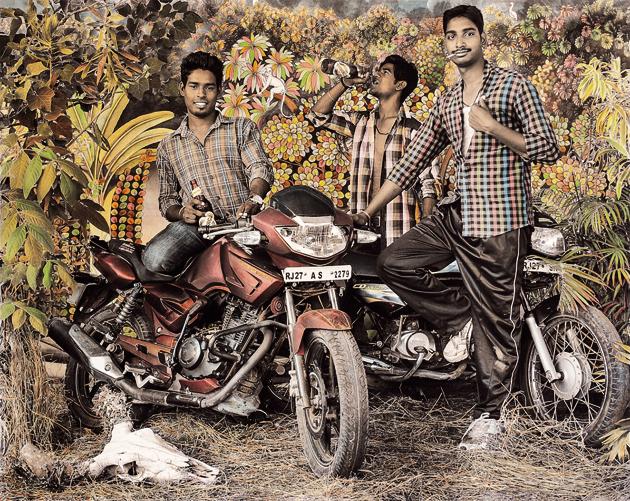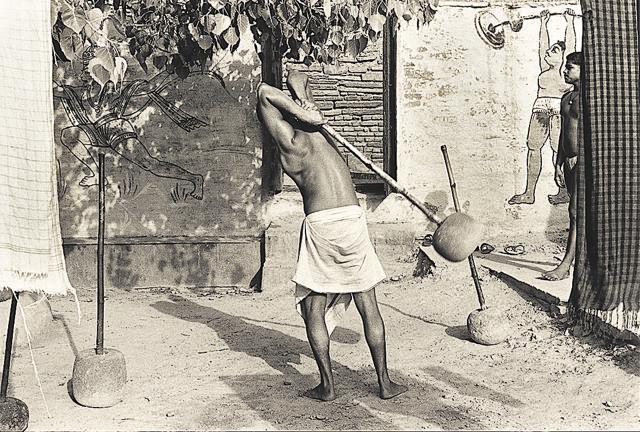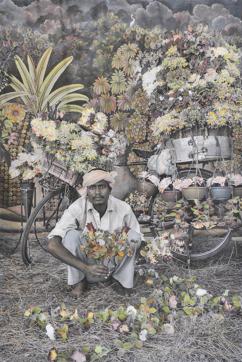#NoFilter: What not to miss at Mumbai’s Focus Photography Festival
25 venues celebrate photos as art, as record and as a medium of change. What will you see first?
Wearing a loincloth, his back to viewers, a wrestler lifts a gadha (a traditional mace), using all the strength in his ripped arms, and twists it to hammer it down. Right then, American photographer William Gedney freezes the moment in a black-and-white photograph.

The picture of an akhada (a rudimentary gym) also captures hand-painted art on the walls of either side of the man. One features a proud wrestler, holding a dumbbell in his stretched arms; the other is of Hanuman, the deity noted for his strength. The composition is lucid, it seems almost in motion. You can well imagine what happened before the moment was captures and what will happen next.

The legendary street photographer’s image of the wrestler, along with shots of handcarts and huge courtyards shot between 1969 and 1980 are fittingly the opening show at the Focus Photography Festival. It’s the third edition of the biannual event that runs across various Mumbai venues in March. This year’s theme is Memory – how photos create it, influence it, question it and, in the digital age, even refashion it.
Matthieu Foss, one of the founders of the festival says that photography and memory are inherently linked. “Photography, since its invention, has been used to document history,” he says. “That documentation is now the basis for understanding large sections of our past as factual truth.”
The Gedney pictures are on view at the Chhatrapati Shivaji Maharaj museum. But there are 25 shows across Mumbai to keep photo buffs busy. At Project 88, Chirodeep Chaudhuri’s trips to the People’s Free Reading Room And Library over 15 months capture a repository of knowledge that its itself becoming mere memory. The Bhau Daji Lad Museum hosts Autobiography as Memory, with works from 18 artists that make you question the meaning and relevance of biography today. At Akara Art is Masterji, a show by 94-year-old Maganbhai Patel, who moved to Coventry, UK, as a young boy and started documenting the South Asian community there.
Put your selfie camera away and let these photos change your mind about that images mean to us in 2017.
Read: In Delhi, Rohit Chawla turns famous faces into Frida Kahlo. Do their brows measure up?
History in pictures
William Gedney in India shows the less-documented side of the country. “Unlike most foreign photographers who chose exotic India as their subject, Gedney’s pictures show that he had a great connect and an empathy with his subjects,” says Kamini Sawhney of the Jehangir Nicholson Art Foundation that has organised the show.

Gedney often lived with his subjects and established a relationship with them. He stayed with a family in Banaras for 18 months. His pictures, be it the wrestler in Banaras, girls playing cards in Calcutta or a street photographer in Delhi, show his connection to his subjects. “They provide not just a voyeuristic view, but are like a social documentary that speaks of humanity at large.”
Photos as evidence
Photographer Anusha Yadav of The Memory Company displays crime investigation photographs from 19th and 20th century India, at Chemould Prescott Road’s exhibition Access Time. The pictures trace how photos were used as court evidence, and subsequently became an archive of criminal history in India.

A 1937 photograph, Police Officer with a Thugee, shows chief inspector Jim Scott who had been stabbed in the face with a knife by the man standing next to him (the ‘thuggee’). “When confronted with these images, we enter a world few have witnessed firsthand; most of these images have never been seen in public,” says Yadav. The images, she says, may provok frustration, by revealing alternate possibilities and secrets. “Perhaps proof that one can never know the exact truth about our pasts, even with such seemingly absolute evidence as a photograph.”
READ: Photographs zoom in on India's marginalised groups
Hand-painted memories
At Tarq, American photographer Waswo X Waswo who has been documenting people in Rajasthan since 2002 aims his lens on the invisible among the crowds. The show, Photowallah, “brings into focus people we often forget, like a coriander seller,” says Hena Kapadia of Tarq.

The technique is interesting too. Waswo shoots in black-and-white, then Rajesh Soni, an artist from Rajasthan, handpaints each image. “This technique was practised by many photographers and amateurs earlier, and was extensively used on family albums,” says Kapadia. “Waswo has made a place for it in art photography.”
The artist’s love for Rajasthan, which he now calls home, is evident in the rose-tainted glasses with which he views his subjects. For viewers it may also trigger memories of photographs in their own families.
So, could your Insta-feed be art one day?
Perhaps: “Like everything, great photographs are made with practice, a certain thought process and inspiration,” says gallerist Matthieu Foss. “The technicalities are only tools to help achieve visual objectives. And yes, even with phones you can create powerful work.”
Perhaps not: Photographer Waswo X Waswo says pictures have lost their historical significance in the digital era. “Before the advent of digital media we used to really look,” he says. “Pictures would say something about the past. Now they’re a shout-out about where one is and what is one doing. Art photography is what looks at history. People would find that value in it even 50 years or 100 years later.”
WHAT: Focus Photography Festival
WHERE: Across 25 venues in Mumbai including museums, art galleries and cafes
WHEN: March 9 to March 23
FOR DETAILS : Visit Focusfestivalmumbai.com/
ENTRY: Free, but some venues may charge an admission fee
Hungry for more? Here's a virtual exhibtion featuring someone very familar
Catch your daily dose of Fashion, Health, Festivals, Travel, Relationship, Recipe and all the other Latest Lifestyle News on Hindustan Times Website and APPs.



